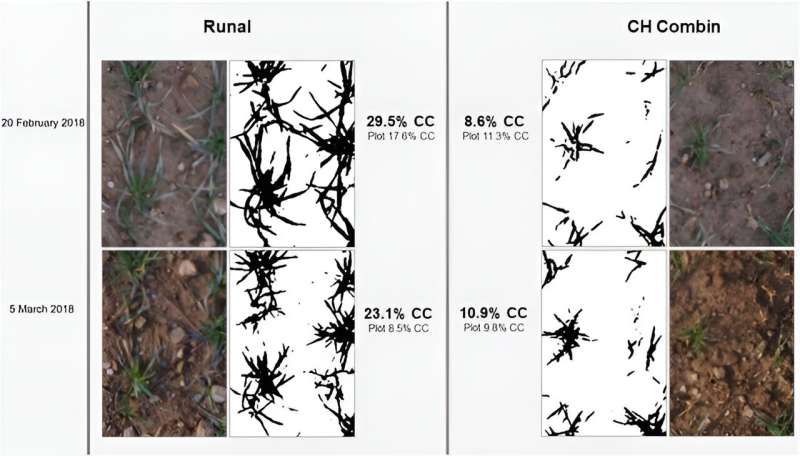This article has been reviewed according to Science X's editorial process and policies. Editors have highlighted the following attributes while ensuring the content's credibility:
fact-checked
proofread
Enhancing crop resilience: A novel approach to quantifying and predicting frost damage in winter wheat

Abiotic stresses such as heat and frost severely limit plant growth, particularly affecting winter crops like wheat through senescence and leaf area reduction. Modern phenotyping methods, particularly high-throughput field phenotyping (HTFP), have made significant advances in monitoring and analyzing these effects.
Current research focuses on the use of detailed, high-resolution images to quantify growth traits and assess damage from stresses such as frost. However, challenges remain in accurately modeling frost damage and understanding genotype-specific resilience. The challenge is to improve the accuracy of detecting and quantifying crop responses to abiotic stresses, particularly frost, to improve resilience and yield in varying climates.
In October 2023, Plant Phenomics published a research article titled "Frost Damage Index: The Antipode of Growing Degree Days."
This research quantified frost-induced reductions in plant growth by monitoring changes in canopy cover of thirty-six winter wheat genotypes over several years using time-resolved, high-resolution field imagery. A new concept, the Frost Damage Index (FDI), was developed to cumulatively summarize frost events, similar to growing degree days.
Genotypes' sensitivity to the FDI correlated with traditional visual scores used to assess winter hardiness, indicating their potential adaptability to other stresses such as drought or heat. The study spanned three years, each with different temperature regimes and cold spells.
The focus was on the first 150 days after sowing, representing winter, and different patterns of canopy cover loss (ΔCC) and temperature dynamics were observed each year. A moderate to strong correlation was found between ΔCC and manual frost ratings after cold spells, indicating the effectiveness of the FDI in capturing genotype-specific frost sensitivity.
The research process involved optimizing various parameters, including a three-day lag time between cold spells and visible damage, a smoothing factor for temperature data, and a base temperature (Tbase) of -9°C below which visible frost damage occurs. The genotype-specific sensitivity factor(s) was also calculated and significantly improved the predictive accuracy of ΔCC when used.
The study confirmed that the inclusion of a lag phase and the smoothing of temperature curves significantly improved prediction accuracy. It also highlighted the genotype-specific nature of frost damage sensitivity, which necessitates the adjustment of parameters such as the sensitivity factor for each genotype.
Overall, the results highlighted the potential of the FDI in enhancing predictions of plant performance under frost stress, suggesting its use in breeding for frost-tolerant genotypes and improving crop models by incorporating damage effects.
This study represents a methodological advance in understanding and predicting genotype-by-environment interactions, particularly in relation to frost damage, by using high-throughput field phenotyping methods.
More information: Flavian Tschurr et al, Frost Damage Index: The Antipode of Growing Degree Days, Plant Phenomics (2023). DOI: 10.34133/plantphenomics.0104
Provided by Plant Phenomics




















